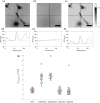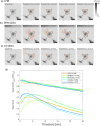Quantitative phase imaging of adherent mammalian cells: a comparative study
- PMID: 31259050
- PMCID: PMC6583341
- DOI: 10.1364/BOE.10.002768
Quantitative phase imaging of adherent mammalian cells: a comparative study
Abstract
The Quantitative phase imaging methods have several advantages when it comes to monitoring cultures of adherent mammalian cells. Because of low photo-toxicity and no need for staining, we can follow cells in a minimally invasive way over a long period of time. The ability to measure the optical path difference in a quantitative manner allows the measurement of the cell dry mass, an important metric for studying the growth kinetics of mammalian cells. Here we present and compare cell measurements obtained with three different techniques: digital holographic microscopy, lens-free microscopy and quadriwave lateral sheering interferometry. We report a linear relationship between optical volume density values measured with these different techniques and estimate the precisions of this measurement for the different individual instruments.
Conflict of interest statement
C. Allier and L. Hervé are inventors of a patent devoted to the holographic reconstruction. LSI as a QPI technique has been developed by J. Savatier and S. Monneret thanks to a close scientific collaboration with Phasics company.
Figures








Similar articles
-
Living cell dry mass measurement using quantitative phase imaging with quadriwave lateral shearing interferometry: an accuracy and sensitivity discussion.J Biomed Opt. 2015;20(12):126009. doi: 10.1117/1.JBO.20.12.126009. J Biomed Opt. 2015. PMID: 26720876
-
Label-Free and Quantitative Dry Mass Monitoring for Single Cells during In Situ Culture.Cells. 2021 Jun 29;10(7):1635. doi: 10.3390/cells10071635. Cells. 2021. PMID: 34209893 Free PMC article.
-
Optical detection and measurement of living cell morphometric features with single-shot quantitative phase microscopy.J Biomed Opt. 2012 Jul;17(7):076004. doi: 10.1117/1.JBO.17.7.076004. J Biomed Opt. 2012. PMID: 22894487
-
Quantitative phase microscopy for evaluation of intestinal inflammation and wound healing utilizing label-free biophysical markers.Histol Histopathol. 2018 May;33(5):417-432. doi: 10.14670/HH-11-937. Epub 2017 Oct 9. Histol Histopathol. 2018. PMID: 28990642 Review.
-
Sample and substrate preparation for exploring living neurons in culture with quantitative-phase imaging.Methods. 2018 Mar 1;136:90-107. doi: 10.1016/j.ymeth.2018.02.001. Epub 2018 Feb 10. Methods. 2018. PMID: 29438830 Review.
Cited by
-
Quantitative phase microscopies: accuracy comparison.Light Sci Appl. 2024 Oct 11;13(1):288. doi: 10.1038/s41377-024-01619-7. Light Sci Appl. 2024. PMID: 39394163 Free PMC article. Review.
-
Biomass measurements of single neurites in vitro using optical wavefront microscopy.Biomed Opt Express. 2022 Nov 17;13(12):6550-6560. doi: 10.1364/BOE.471284. eCollection 2022 Dec 1. Biomed Opt Express. 2022. PMID: 36589583 Free PMC article.
-
Quantitative Phase Imaging: Recent Advances and Expanding Potential in Biomedicine.ACS Nano. 2022 Aug 23;16(8):11516-11544. doi: 10.1021/acsnano.1c11507. Epub 2022 Aug 2. ACS Nano. 2022. PMID: 35916417 Free PMC article. Review.
-
Alternation of inverse problem approach and deep learning for lens-free microscopy image reconstruction.Sci Rep. 2020 Nov 19;10(1):20207. doi: 10.1038/s41598-020-76411-9. Sci Rep. 2020. PMID: 33214618 Free PMC article.
-
Detecting abnormal cell behaviors from dry mass time series.Sci Rep. 2024 Mar 25;14(1):7053. doi: 10.1038/s41598-024-57684-w. Sci Rep. 2024. PMID: 38528035 Free PMC article.
References
LinkOut - more resources
Full Text Sources
